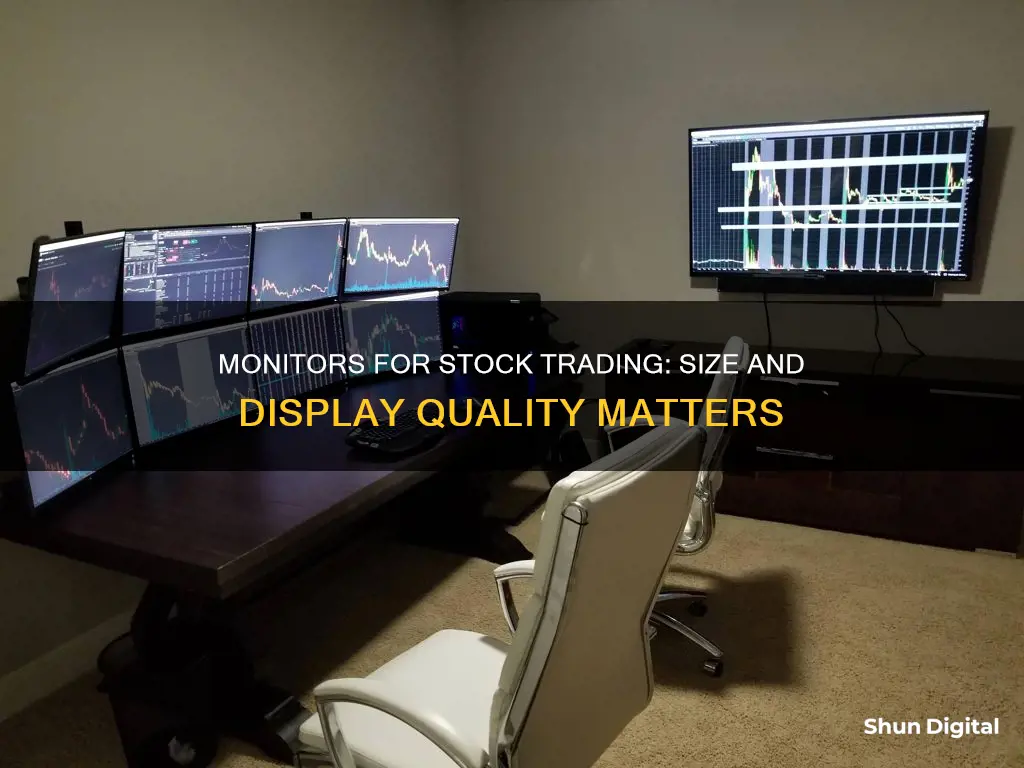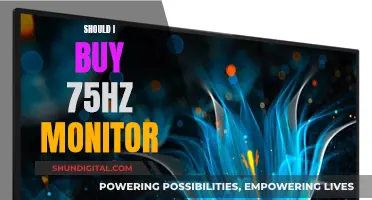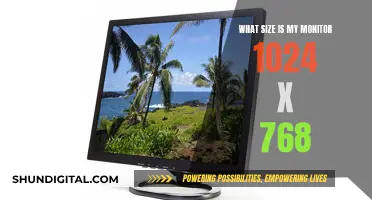
When it comes to stock trading, having the right monitor setup is crucial. The amount of data and charts that need to be displayed simultaneously means that a good monitor can give traders a significant edge. While some traders make do with a laptop or a single monitor, serious traders often opt for multiple monitor setups to track numerous charts and indicators. The ideal number of monitors depends on how many charts one wants to keep track of, with most monitors being able to fit a maximum of four charts. Thus, a trader wanting to track 12 or 16 charts simultaneously might opt for three or four monitors, respectively.
When choosing a monitor for stock trading, there are several key factors to consider. Firstly, the physical size of the monitor matters, with larger monitors providing more screen real estate to display charts and data. Additionally, the resolution of the monitor is important, as a higher resolution means a higher number of pixels, resulting in sharper images and more space to work with. A resolution of 1920 x 1080p or higher is generally recommended. Other features to look for include ergonomic adjustments, VESA compatibility for easy mounting, and blue light filters to reduce eye strain.
Some popular monitor options for stock trading include the Dell UltraSharp U2720Q 27” monitor, the ViewSonic OMNI VX2418-P-MHD 24” monitor, and the Dell 24.5” S2522HG monitor. For those seeking a single large monitor, the Samsung 49” Odyssey Neo G9 G95NA and the LG 34WN80C-B 34” UltraWide monitor are also highly regarded. Ultimately, the best monitor setup depends on individual preferences, trading style, and budget.
| Characteristics | Values |
|---|---|
| Resolution | 1920 x 1080 or higher |
| Screen size | 24 inches or larger |
| Ergonomics | Swivel, tilt, and height adjustment |
| VESA compatibility | VESA mounts for multiple monitors |
| Blue light filter | Yes |
| Curved screen | Optional |
What You'll Learn

Resolution and screen size
Resolution
A monitor's resolution refers to the number of pixels it can display. A pixel is a tiny dot of light, and screens use pixels to produce the image you see. A higher resolution means a higher number of pixels, which can result in either:
- Higher definition and more detail: The pixels on a higher-resolution screen will be smaller, so images will look smoother and more detailed.
- More space to work with: A higher-resolution screen has more pixels, so you'll have more room to fit your charts, spreadsheets, etc.
For stock trading, the second benefit is generally more useful. A resolution of 1920 x 1080p or higher is recommended.
Screen Size
The bigger the monitor, the more charts you can fit on it. However, very large screens can be imposing and take up a lot of space. A good balance might be to use multiple smaller monitors (e.g. two 24" or 25" screens) instead of one large one. This also allows for more flexibility in arranging your setup, as you can position the smaller monitors where you want them.
If you do opt for a larger screen, make sure it's at least 40" if you're going for a 4K resolution, or 32" for QHD, to avoid needing to use scaling, which can reduce the amount of usable space.
Combining Resolution and Screen Size
When choosing a monitor, it's important to consider both the resolution and the screen size together. A higher-resolution screen will have more pixels, so if you want those pixels to be the same size as on a lower-resolution screen, the physical size of the higher-resolution screen will need to be larger.
For example, a 21.5" screen with a resolution of 1920 x 1080 (FHD) will have perfectly usable text and icon sizes. However, a 21.5" 4K screen (3840 x 2160) will have four times the number of pixels, so all text, icons, charts, etc. will appear four times smaller unless you use scaling.
To get the benefits of higher resolution (more space to work with) without the drawbacks of tiny text and icons, you need to go for a larger screen. A 4K screen would need to be at least 43" to have the same-sized pixels as a 21.5" FHD screen.
Other Considerations
- Cost: Larger screens and higher resolutions tend to be more expensive.
- Ergonomics: Consider the physical space you have available and how you want to arrange your setup. You may also want to look for monitors with adjustable stands that allow for tilt, swivel, and height adjustment.
- VESA compatibility: If you're planning to use multiple monitors, VESA compatibility will make it easier to mount them.
- Blue light filter: Blue light can cause eye strain and affect sleep, so a blue light filter may be a useful feature.
Recommendations
Based on the above considerations, here are some recommended monitors for stock trading:
- Dell UltraSharp U2720Q 27” Monitor: This flat-screen monitor has a resolution of 3840 x 2160, thin bezels, and has been well-rated since its debut in 2020.
- ViewSonic OMNI VX2418-P-MHD 24” Monitor: This recent release has all the essential features for stock trading and is available at a friendly price point.
- Dell 24.5” S2522HG Monitor: Another recent release, this monitor has received high ratings for its graphic requirements, future-proof connections, and VESA compatibility.
- Dell 27 LED backlit LCD Monitor SE2719H: This 27" monitor from Dell has a resolution of 1920 x 1080, protects your eyes from blue light, and has many ports for connections.
- HP VH240a 23.8-inch Full HD 1080p: This HP monitor offers a wide-angle viewing experience, adjustable height, and tilt, and can be mounted on walls or brackets.
- Philips 276E8VJSB 27" Monitor, 4K UHD IPS: With a resolution of 3840x2160, this monitor delivers ultra-clear picture quality and uses IPS Panel technology to provide the best viewing angles.
- BenQ 24 Inch IPS Monitor: This monitor from BenQ features less blue light and flicker-free technology to reduce eye strain and headaches. It also has a cable management system to neatly store wires.
- Dell S Series Led-Lit Monitor 32" (S3219D): This 32" widescreen monitor from Dell has a resolution of 2560 x 1440, features a flicker-free and low-haze screen, and comes with a variety of ports for connections.
CRT Monitor Sizing: Understanding the Measurement Techniques
You may want to see also

Ergonomic features
When it comes to choosing a monitor for stock trading, ergonomic features are essential to consider for both comfort and productivity. Here are some key ergonomic features to look for:
Swivel, Tilt, and Height Adjustment
The ability to swivel, tilt, and adjust the height of your monitor is crucial for creating a comfortable viewing experience. This flexibility ensures that you can find the perfect viewing angle and position the monitor at eye level, reducing neck strain and improving your overall posture.
VESA Compatibility
VESA compatibility is an important feature if you plan to mount your monitors on a stand or wall. VESA mounts allow you to attach multiple monitors together, saving desk space and providing a clutter-free setup. Even if you don't intend to mount your monitors initially, it's worth considering VESA compatibility for future flexibility.
Blue Light Filter
Blue light emitted by monitors can cause eye strain and affect your sleep. A monitor with a blue light filter can help reduce these negative effects, especially if you spend long hours trading. While some monitors have built-in blue light filters, you can also purchase stick-on blue light filter screens as a budget-friendly alternative.
Curved vs. Flat Screens
Whether you prefer a curved or flat screen for stock trading is a matter of personal preference. Curved monitors provide a more immersive experience and can reduce eye fatigue by engaging your peripheral vision. On the other hand, flat screens can be combined to create a seamless multi-monitor setup, especially if they have thin bezels. Consider your workspace setup and personal comfort when making this decision.
Adjustable Stands
An adjustable stand allows you to adjust the height and tilt of your monitor to find the optimal viewing position. This feature is crucial for creating an ergonomic setup, especially if you use multiple monitors at different heights or angles.
In conclusion, when choosing a monitor for stock trading, prioritize ergonomic features that ensure your comfort and productivity. Look for monitors with swivel, tilt, and height adjustment capabilities, VESA compatibility for mounting options, blue light filters for eye strain reduction, and adjustable stands for customized viewing angles.
Monitor Internet Usage: Bloom Broadband's Comprehensive Solution
You may want to see also

VESA compatibility
Some monitors, such as the ViewSonic VP2468 and VA2456-mhd, are specifically marketed as VESA-compatible and can be easily attached to VESA mounts without the need for additional adapters. This can be a convenient feature if you plan to use multiple monitors for stock trading and want a clean and flexible setup.
In addition to VESA compatibility, there are other factors to consider when choosing a monitor for stock trading, such as screen size, resolution, refresh rate, and ergonomic features. It's important to find a monitor that suits your specific needs and trading style.
Monitoring Power Usage: RV Hookup Management
You may want to see also

Blue light filter
Blue light is a type of high-energy light emitted by computer screens that can cause eye strain and adversely affect sleep. Blue light filters are essential, especially for traders or professionals who use multiple monitors, as blue light can seep into their vision not just from the front but also from the sides.
Some monitors are also marketed specifically for traders and come with built-in blue light filters. For example, the ViewSonic VG2455 monitor has a blue light filter and built-in ergonomic features, including swivel, pivot, and height adjustment for increased productivity and comfort.
How Monitor Size Impacts Website Viewing Experience
You may want to see also

Curved vs multiple screens
When it comes to choosing between a curved or multiple flat screens for stock trading, there are several factors to consider. Here are some advantages and disadvantages of each option:
Curved Monitors
Curved monitors offer a more immersive viewing experience and can provide a wider field of view, which may be beneficial when tracking multiple charts and data points. They can also help reduce eye strain by engaging your peripheral vision and allowing you to view information with less eye movement. Curved monitors often have a higher resolution, providing clearer and sharper images. Additionally, they can create a more aesthetically pleasing setup, especially if you opt for an ultrawide curved monitor.
However, one of the main drawbacks of curved monitors is the potential for chart distortion, especially if you are not sitting directly in front of the screen. Curved monitors may also be more challenging to mount, especially if you have multiple screens, as their size and curvature can create complications. They tend to be more expensive than flat monitors, and if you require multiple screens, the cost can add up quickly.
Multiple Flat Screens
Using multiple flat screens is a popular choice among traders as it allows for greater flexibility in terms of screen arrangement and provides a more expansive viewing area. With flat screens, you can easily add or remove screens as needed, and they are generally more affordable than curved options. Additionally, flat screens are more widely available, giving you a broader range of options to choose from.
One disadvantage of multiple flat screens is that they can take up more desk space, especially if you require many screens. Another consideration is that the bezels of flat screens can be distracting, impacting the overall viewing experience, although this can be mitigated by choosing screens with thin bezels.
In summary, both options have their advantages and disadvantages. Curved monitors offer a more immersive experience and can reduce eye strain but may suffer from chart distortion and mounting complications. Multiple flat screens provide greater flexibility and are often more affordable, but they can take up more space and may require careful arrangement to minimize the impact of screen bezels. Ultimately, the choice between curved and multiple flat screens depends on your personal preferences, budget, and specific requirements as a stock trader.
Measuring LED Monitors: Screen Sizing Simplified
You may want to see also
Frequently asked questions
The best size for a monitor depends on your requirements and preferences. If you want to view multiple charts simultaneously, a larger screen or multiple monitors may be ideal. Common monitor sizes for stock trading include 24, 27, 32, and 40 inches.
The number of monitors needed depends on individual preferences and trading strategies. Some traders use a dual-monitor setup, while others may opt for up to 20 monitors. It's recommended to calculate the number of monitors based on how many charts you want to track at once, as most monitors can comfortably fit a maximum of four charts.
A high-resolution monitor is beneficial for stock trading to ensure clear visibility of charts and data. A resolution of 1920 x 1080 (Full HD) or higher is generally recommended.
The choice between a flat or curved monitor depends on personal preference. Curved monitors provide a more immersive experience and can reduce eye fatigue by engaging your peripheral vision. However, they may be more expensive and can be challenging to mount.
In addition to a high resolution, look for features such as VESA compatibility for easy mounting, blue light filters to reduce eye strain, ergonomic design for comfort, and multiple ports for connectivity.







